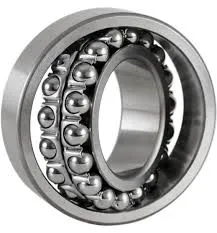
Nov . 05, 2024 04:17 Back to list
taper rolling bearing supports
Taper Rolling Bearing Supports Design, Applications, and Advantages
Taper rolling bearings are an essential component in various mechanical systems, providing effective support and enabling smooth rotational movement. These bearings are designed with tapered raceways and rolling elements, which not only facilitate axial and radial load support but also ensure high stability and durability. In this article, we will delve into the characteristics, advantages, and applications of taper rolling bearing supports, underscoring their significance in modern engineering.
Design Characteristics
The unique design of taper rolling bearings is characterized by their conical shape, which allows the rolling elements to make contact at a single line, resulting in lower friction as compared to other types of bearings. This design feature makes taper rolling bearings highly effective for handling both radial and axial loads. Furthermore, the arrangement of the rollers enables the bearings to accommodate heavy loads and maintain excellent rigidity under various operating conditions.
Manufacturers often utilize high-quality materials, such as steel or special alloys, for the rolling elements and raceways to ensure longevity and reliability. Moreover, taper rolling bearings can be categorized into various types, including single-row, double-row, and four-row configurations, each designed for specific load conditions and applications. The ability to customize the bearing design makes them applicable in a wide range of industries.
Advantages of Taper Rolling Bearings
1. High Load Capacity Taper rolling bearings can support both axial and radial loads simultaneously, making them ideal for heavy-duty applications. Their tapered design distributes the load across the rolling elements effectively, allowing them to handle higher loads than other bearing types.
2. Durability and Longevity The use of superior materials and precise manufacturing processes contributes to the durability of taper rolling bearings. They are resistant to wear and can operate at high speeds and temperatures, which is crucial in applications where reliability is paramount.
3. Reduced Friction The design of taper rolling bearings minimizes the contact area between the rolling elements and the raceways, significantly reducing friction. This characteristic leads to lower energy consumption and enhanced efficiency, ultimately contributing to overall system performance.
4. Self-Alignment Capability Taper rolling bearings can handle misalignments and shaft deflections, which may occur during operation. This feature is particularly beneficial in systems where installation precision may be challenging.
taper rolling bearing supports

Applications of Taper Rolling Bearing Supports
Taper rolling bearings find extensive usage across various industries due to their excellent performance characteristics. Here are some common applications
1. Automotive Industry In vehicles, taper rolling bearings are commonly used in wheel hubs, transmission systems, and axle assemblies. They support the high loads and stresses experienced during vehicle operation while ensuring smooth and efficient movement.
2. Aerospace Engineering The aerospace sector utilizes taper rolling bearings in landing gears, engine components, and other critical systems that require utmost reliability and performance under extreme conditions.
3. Manufacturing and Machinery In manufacturing equipment, taper rolling bearings support conveyor systems, pumps, and heavy machinery. Their ability to handle considerable loads and resist wear makes them crucial in industrial settings.
4. Construction Equipment Heavy machinery such as excavators, cranes, and bulldozers extensively use taper rolling bearings to ensure stability and strength while operating under high-load conditions.
5. Renewable Energy With the rise of renewable energy solutions, taper rolling bearings are increasingly employed in wind turbines and solar tracking systems, where reliability and efficiency are essential for optimal performance.
Conclusion
Taper rolling bearing supports are a fundamental component in various mechanical systems, delivering exceptional load-carrying capabilities, durability, and efficiency. Their unique design, coupled with the advantages they bring to different industries, underscores the importance of selecting the right bearing for specific applications. As technology continues to evolve, the role of taper rolling bearings will likely expand, further solidifying their place in engineering and manufacturing. The ongoing innovation in this field will undoubtedly lead to enhancements in performance and reliability, securing taper rolling bearings as a vital element in future mechanical designs.
Latest news
-
Premium Deep Groove Ball Bearings | High Speed & Reliability
NewsAug.29,2025
-
Durable Scaffolding Clamps - Secure & Reliable Tube Connectors
NewsAug.28,2025
-
Common Failures in Thrust Ball Bearings and Solutions
NewsAug.22,2025
-
How Tapered Roller Bearings Can Take Shock Loads
NewsAug.22,2025
-
Angular Bearings in High-Precision Spindles
NewsAug.22,2025
-
The Impact of Misalignment on Cylindrical Roller Bearing Performance
NewsAug.22,2025
